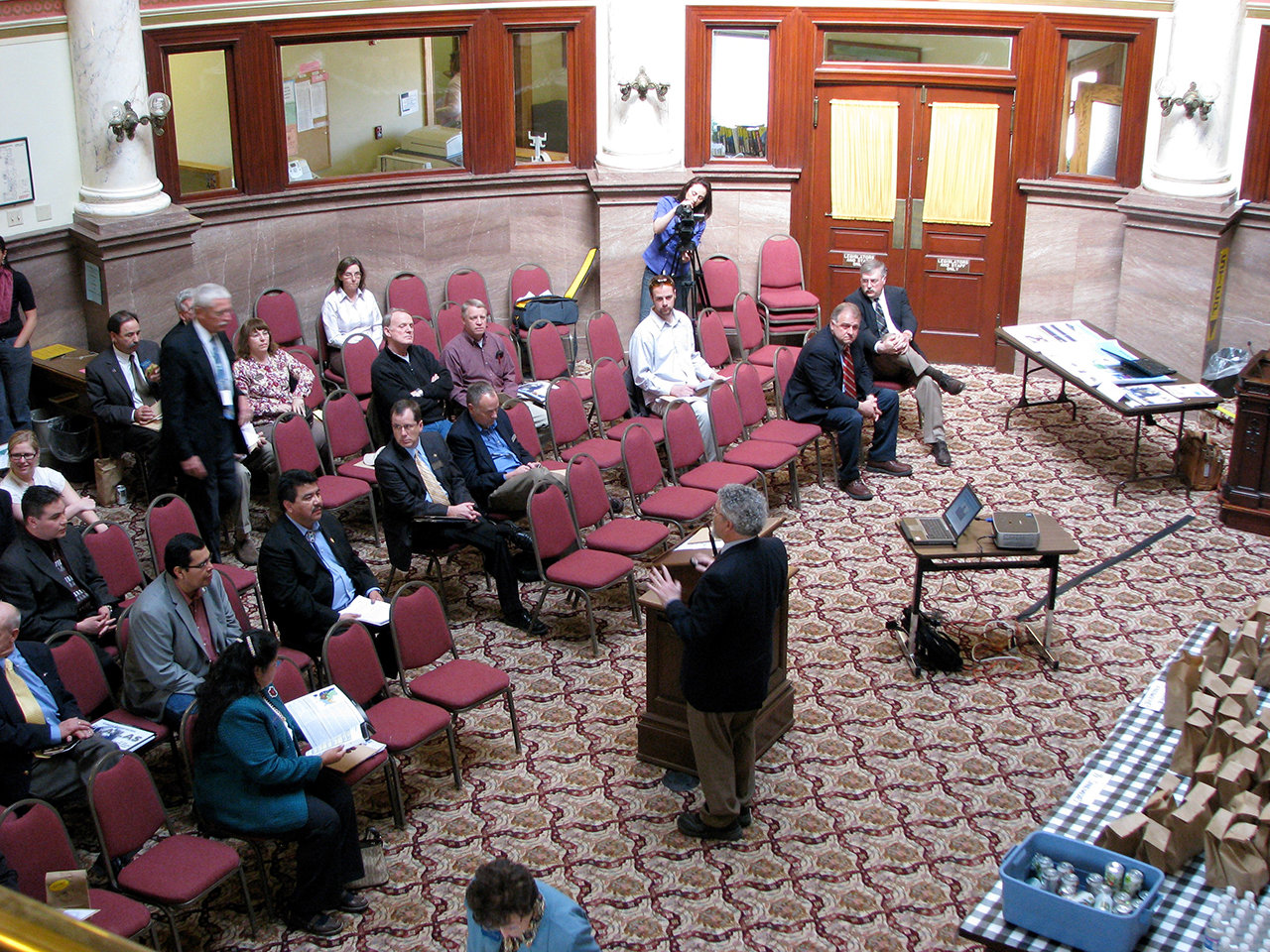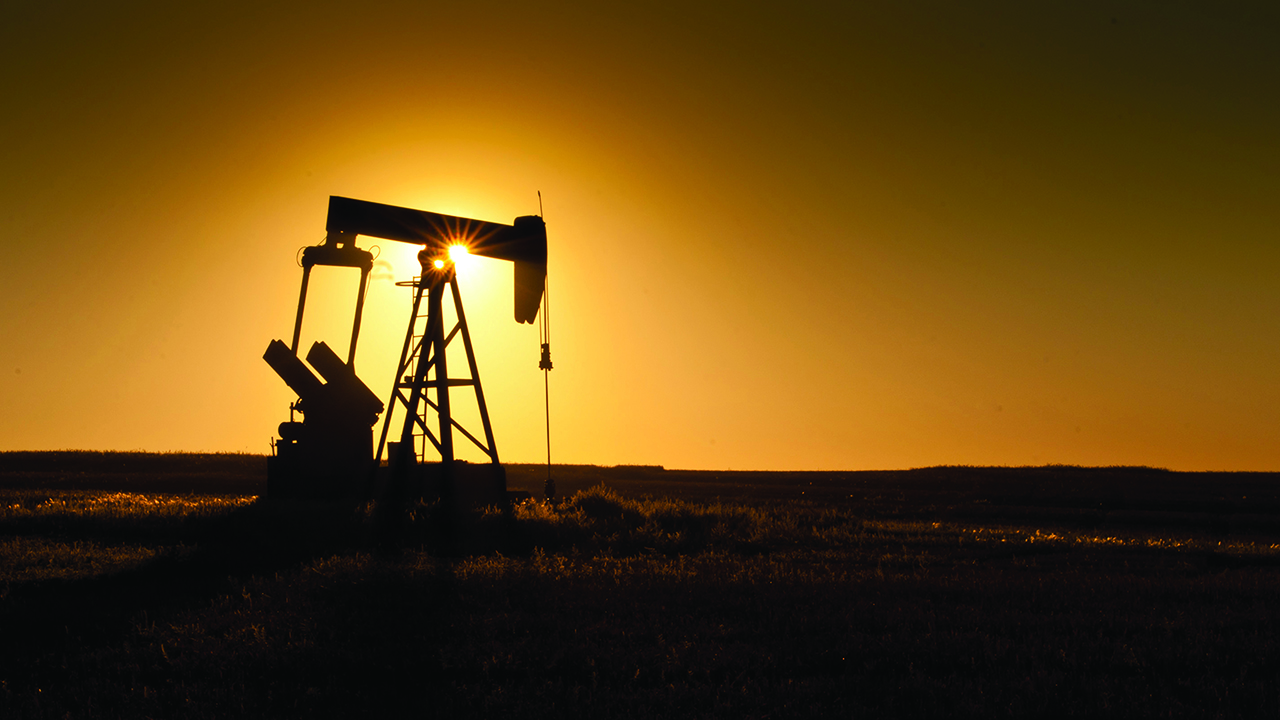Carbon Storage Atlas
- Project Highlights
- Unexpected Findings
- Advice for Storage Operators
- Project Outreach
- Project Commercialization
- Contact Information
Traditional surface seismic methods have had little success in imaging basalt features in onshore areas where the basalt is thinly covered by sediment. Processing of the seismic data included constructing an elastic wavefield model, identifying and separating seismic wave modes, and processing the swath as a single 2D line. Important findings include: (1) a wide variety of shear wave energy modes swamp the P-wave seismic records; (2) ground roll overprints P-wave signal, except at very short geophone offsets; and (3) because of extreme velocity contrasts, P-wave events are refracted at incidence angles greater than 7 to 15 degrees. Subsequent removal of S-wave and other noise during processing resulted in tremendous improvement in image quality.
Continental flood basalts represent one of the largest geologic features on the planet and exist in many regions in the United States and around the world. Laboratory studies indicate the CO2 rapidly mineralizes when in contact with formation fluid and basalt minerals. Approximately 1,000 metric tons of CO2 was injected into the Columbia River Basalt Group near Wallula, Washington, over a three-week period during July/August 2013. Post-injection isotopic composition data coupled with groundwater chemistry data and geophysical wellbore surveys conclusively show that injected supercritical CO2 was being actively converted to a stable carbonate mineral in the basalt reservoir within 24 months of emplacement. This is the first field evidence of in-situ carbonation occurring from a free-phase CO2 injection.
To the knowledge of BSCSP, this is the largest such seismic survey ever performed. The project also developed a processing workflow and performed the first quadri-joint inversion of seismic data to date. The three-step workflow involved: (1) pre-stack stratigraphic inversion; (2) computation of registration law (warping); and (3) joint pre-stack stratigraphic inversion. The resulting impedance and density estimates from the quadri-joint inversion combine reflection coefficient information from all modes used producing a more accurate estimate of each of the three isotropic parameter combinations resolvable by surface seismic data. In particular, the density attribute is much more robustly recovered than would be the case using PP or PS data only.
The core acquired contains seven different depositional environments (basin, slope, fore-reef, shallow fore-reef, high-energy shoal/biostrom, lagoon, and tidal flat) and represents a rich dataset that can provide valuable insight into fractured carbonate storage reservoirs. The core also exhibits multiple fractures containing precipitate, providing the opportunity for laboratory core-scale studies of natural fractures and dual permeability systems. Additionally, the primary and secondary caprocks (tight carbonate and evaporite, respectively) were also cored, enabling investigation of caprock mechanical and geochemical properties.
A geostatic model in Petrel was developed that used multi-component seismic data and a Bayesian estimator technique to interpolate rock type and porosity between wells, potentially providing a more realistic volumetric model. In addition, a multiple interacting continua model that considers global fracture-fracture connections, global matrix-matrix connections, and local fracture-matrix connections was developed to improve simulation of fractured reservoirs. This model was informed by log and core data and well test data from the Kevin Dome site.
Working through CEC, WESTCARB researchers provided important technical information needed by lawmakers, contributing to the foundations for policy recognizing CCS as an option for reducing greenhouse gas (GHG) emissions in California. In 2007, WESTCARB researchers contributed to a report prepared in response to legislation, Assembly Bill 1925, asking for recommendations on how the state could “develop parameters to accelerate the adoption of cost‐effective geologic sequestration strategies for the long‐term management of industrial carbon dioxide.” In 2010, WESTCARB researchers served on the Technical Advisory Committee to the California Carbon Capture and Storage Review Panel, and contributed to the Background Report accompanying the panel’s final report. This report was a resource document for the 2018 California Carbon Capture and Sequestration Protocol under the Low-Carbon Fuel Standard (LCFS).
One of the unique aspects of the WESTCARB region is the abundance of opportunities for terrestrial storage in forests. Development of such projects was supported by progressive policies in California, Washington, and British Columbia to reduce CO2 emissions. For example, California amended the Forest Practice Act of 1973 to ensure that the rules governing commercial forest harvesting considered the capacity of terrestrial storage to help the state meet its reduced GHG goal. WESTCARB researchers explored a number of options for carbon management through terrestrial storage, including afforestation of rangelands (including planting of fast-growing poplar trees), forest fuel-load reduction and possible subsequent biomass production, and improved conservation-based forest management. Results of the Phase II pilot in California showed that afforestation of rangelands and past fire sites has the potential to make a significant contribution to the state’s efforts to meet its GHG reduction goals. The studies also suggested that there would be strong support from private landowners for such projects.
The seismic data contained several surprises. The target zone was an approximately 30.5-meter (100-foot)-thick porosity zone in a stiff carbonate rock, which should be challenging to image via seismic. However, several joint inversions illustrated very good contrast for this zone. The second surprise was that despite core, log, and well test data indicating existing, open, oriented fractures in the subsurface that contribute to effective permeability, no significant shear wave splitting was observed in the seismic data, which would normally be expected for a fractured reservoir.
It is important to engage stakeholders and the local community before beginning field activities. Without doing so, it is very difficult to build trust in the community. Advice that the Big Sky Carbon Sequestration Partnership (BSCSP) would offer to a new storage operator would be to strongly consider having a community liaison to ensure rapid and transparent communication. If doing saline storage, assess reservoir water-quality issues as early as possible in the project. Existing water data may be sparse and unreliable (depending on how sampling was performed), and regional trends can be deceptive; this is critical information to obtaining an injection permit.
Stakeholder and public engagement is a vitally important part of any geologic storage project. Among the goals of stakeholder engagement are to build understanding of project objectives, how project activities will be conducted, and potential benefits to local and regional stakeholder groups and the public. Additionally, outreach efforts can educate decision-makers and targeted stakeholders about the critical role of carbon storage technologies and build dialogue about the region’s energy future.
Outreach efforts were important for all phases of BSCSP’s project. BSCSP established the Big Sky Energy Future Coalition, a high-level group of approximately 40 participants with a stake in regional, national, and global energy policy – business, labor, environmental groups, farmers and public officials – to establish a dialogue between interested parties to better understand the economic-, political-, technical-, and value-based impediments to commercial deployment of carbon capture and storage (CCS). BSCSP also hosted an annual Big Sky Energy Forum to describe the partnership’s activities. The presentations and subsequent discussions were used as an education and outreach tool to better inform the public and improve understanding of the alternatives and trade-offs associated with meeting the region’s energy needs. BSCSP reached out to the Montana State legislature hosting a symposium for the purpose of informing policy development by elected and appointed officials. Presentations on the fundamental aspects of CCS were given to a Montana Legislative subcommittee, and were followed by a poster session detailing site characterization, monitoring, and injection operations. This, as well as outreach to other state legislative bodies in the region, contributed to three states in the BSCSP area being among the first to pass laws defining pore space ownership.

Lee Spangler addressing a Montana Legislature Subcommittee.
Over the course of the project, BSCSP prepared informational items for a variety of audiences. Quarterly newsletters, posters, brochures, and fact sheets, as required, were produced to effectively communicate the BSCSP’s messages. The materials were made available through the partnership’s website (http://www.bigskyco2.org), as well as by maintaining an inventory of hard copies for distribution.
ngagement was critical to moving the Phase II Wallula basalt pilot test forward. After an initially selected test site (a proposed 750-megawatt integrated gasification combined cycle [IGCC] power plant with carbon capture and storage [CCS]) fell through when the major financial backer terminated support for the power plant, selection and acceptance of an alternative site was made possible with outreach efforts of the Battelle staff. Negotiations to conduct the pilot on the property of the Boise White Paper Mill were successfully concluded in August 2008. Meetings were held with community leaders and key media leads, interviews and small meetings/focus groups were conducted with stakeholders, and an open house and tours were provided. Through the various community engagement approaches and accurate media coverage, there was a much better understanding of the pilot project’s objective and improved public trust, ultimately paving the way for the pilot test to move forward.
In Phase III, BSCSP held an open house in Shelby, Montana, the largest town in the project region. A presentation on the project was given to school children in Sunburst, the town nearest to the proposed injection site, as well as offering the opportunity for the school kids to visit the site on a field trip. Appreciation of the importance of good relations with local landowners and residents was acknowledged with a Community Appreciation BBQ.
Throughout the project, BSCSP was an active participant in the Outreach Working Group – a group providing an essential forum for sharing experiences between the regional partnerships. Ideas and approaches to better communicating developments surrounding carbon capture and storage (CCS) to stakeholders, the interested public, and a variety of policy subsystems associated with energy development in the United States were shared to improve outreach efforts.

Landscape in the BSCSP region (Sunburst, Montana).
The Big Sky Carbon Sequestration Partnership (BSCSP) region possesses vast fossil reserves of coal and both conventional and unconventional oil and gas that can provide energy security and economic growth. With a third of the nation’s coal reserves (approximately 9% of the world’s coal reserves) and emerging shale oil opportunities, restrictions on fossil use could have a large impact on economic opportunities. Conversely, other segments of the region’s economy could be impacted by climate change given the dependence of agriculture on snowpack and tourism on healthy forest and a pristine environment.
BSCSP has served as a resource for companies in the region by providing to industry groups information on storage potential; potential enhanced oil recovery (EOR) opportunities; least-cost pipeline routing analysis; and general information about carbon capture, utilization, and storage (CCUS). Some specific activities include connecting a Korean capture project with a Montana coal plant, resulting in exploration of a pilot test of the Korean technology in Montana. This is of mutual interest because of Montana coal being exported to Korea. BSCSP has provided information on state laws regarding carbon storage to multiple queries from companies exploring regional opportunities that were evaluating potential state-level regulatory impacts. BSCSP also provided information on carbon dioxide (CO2) sources for companies exploring EOR potential. A source of CO2 characterized by BSCSP is being actively explored for EOR use in a depleted oilfield in Montana.
The advent of 45Q, along with favorable state regulations on storage, has led to a recent increase in queries regarding potential projects in the BSCSP region. These are early-stage evaluation efforts that have not yet resulted in projects, but it is clear that favorable changes in regulatory environment are stimulating investigation of potential commercial opportunities.
BSCSP is also active in developing regional mitigation strategy by providing information to state agencies, legislative bodies, and committees, as well as through involvement in the Western Regional Carbon Capture Deployment and the Montana Climate Solutions Council.
In addition, BSCSP is helping the private sector explore additional utilization opportunities and has connected a regional source with a company developing electrochemical methods to reduce CO2 to a platform chemical.
SECARB Contact Information
Director:
Dr. Lee Spangler
spangler@montana.edu
Montana State University
P.O. Box 172465
Bozeman, MT 59717-2465
Tel: (406) 994-1658
Big Sky Carbon Sequestration Partnership Website:
https://www.bigskyco2.org/






